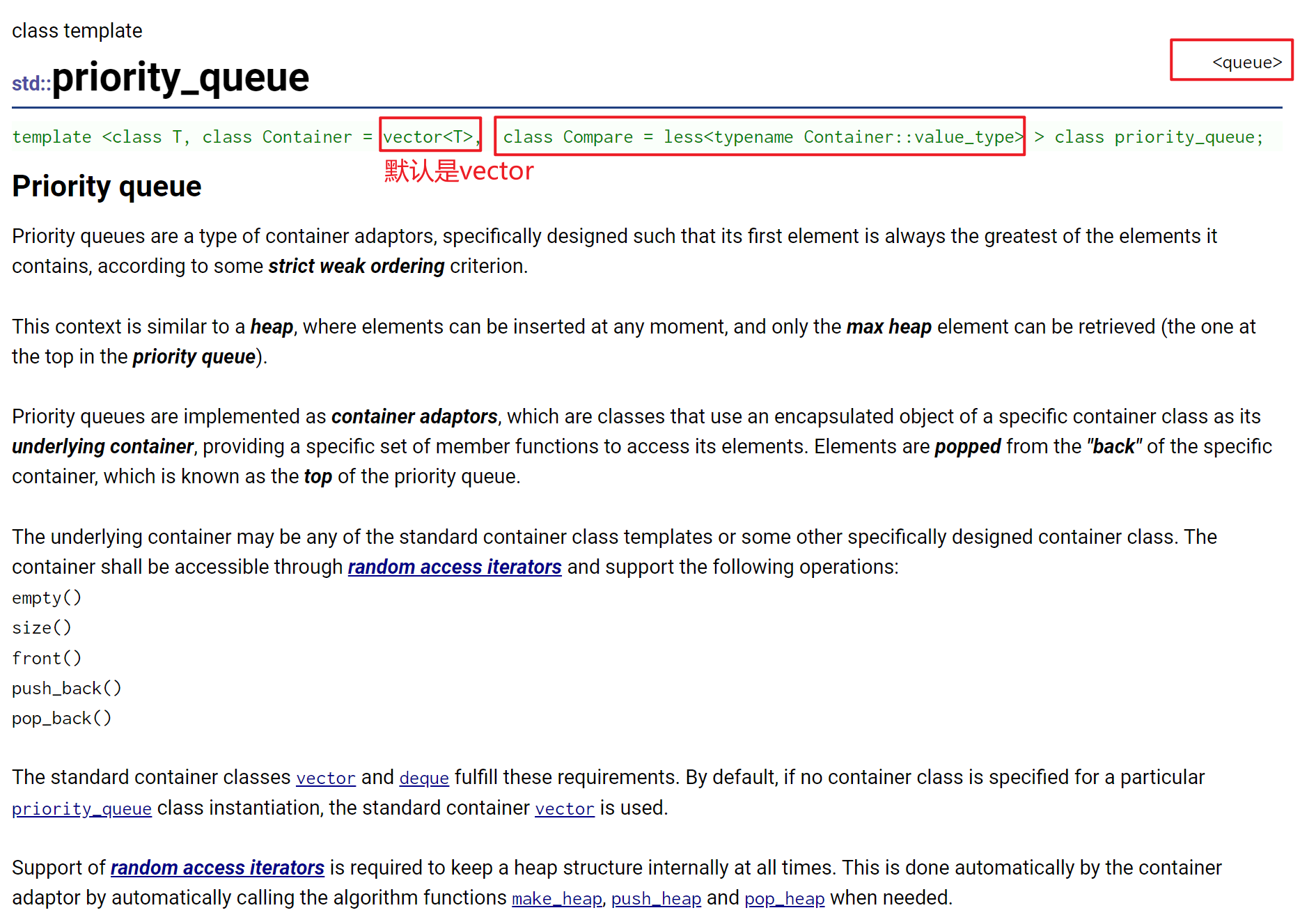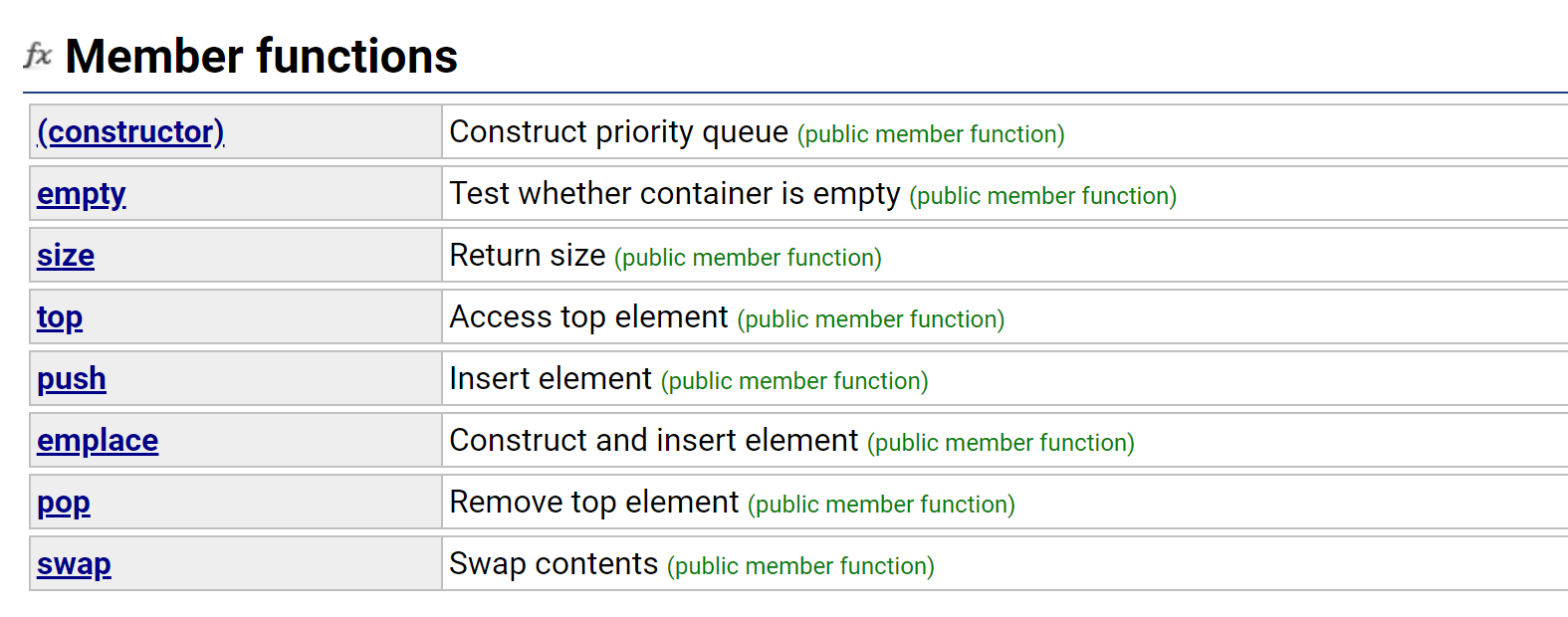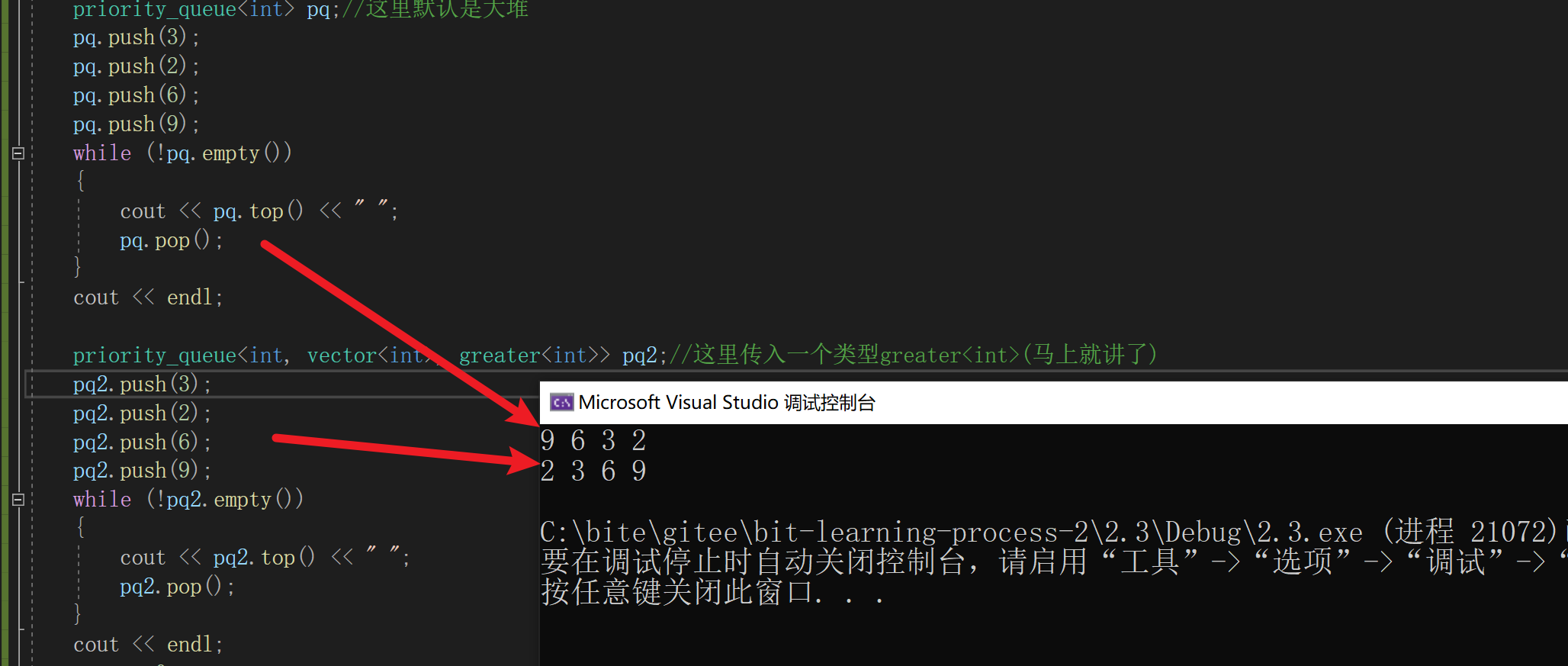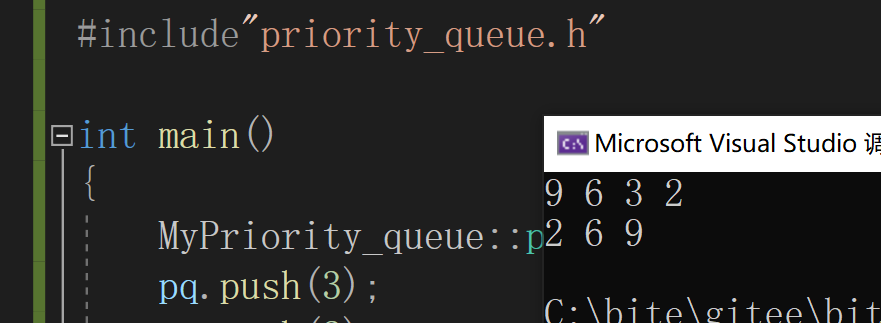C++初阶:容器适配器priority_queue常用接口详解及模拟实现、仿函数介绍
C++初阶:容器适配器priority_queue常用接口详解及模拟实现、仿函数介绍
是Nero哦
发布于 2024-02-25 09:58:58
发布于 2024-02-25 09:58:58
1.priority_queue的介绍和使用
1.1priority_queue的初步介绍

- 优先队列是一种容器适配器,根据严格的弱排序标准,它的第一个元素总是它所包含的元素中最大的(默认是大堆)
- 此上下文类似于堆,在堆中可以随时插入元素,并且只能检索最大堆元素(优先队列中位于顶部的元素)
- 优先队列被实现为容器适配器,容器适配器即将特定容器类封装作为其底层容器类,queue提供一组特定的成员函数来访问其元素。元素从特定容器的“尾部”弹出,其称为优先队列的顶部。
- 底层容器可以是任何标准容器类模板,也可以是其他特定设计的容器类。容器应该可以通过随机访问迭代器访问,并支持以下操作:
- empty():检测容器是否为空
- size():返回容器中有效元素个数
- front():返回容器中第一个元素的引用
- push_back():在容器尾部插入元素
- 标准容器类vector和deque满足这些需求。默认情况下,如果没有为特定的priority_queue类实例化指定容器类,则使用vector。
- 需要支持随机访问迭代器,以便始终在内部保持堆结构。容器适配器通过在需要时自动调用算法函数make_heap、push_heap和pop_heap来自动完成此操作。
1.2priority_queue的使用

函数声明 | 接口说明 |
|---|---|
priority_queue() | 构造一个空的优先级队列 |
priority_queue(first, last) | 构造一个优先级队列,包含范围为[first, last)的元素 |
empty() | 检测优先级队列是否为空,是返回true,否则返回false |
top() | 返回优先级队列中最大(最小)元素,即堆顶元素 |
push(x) | 在优先级队列中插入元素x |
pop() | 删除优先级队列中最大(最小)元素,即堆顶元素 |
#include<iostream>
#include<vector>
#include<queue>
using namespace std;
int main()
{
priority_queue<int> pq;//这里默认是大堆
pq.push(3);
pq.push(2);
pq.push(6);
pq.push(9);
while (!pq.empty())
{
cout << pq.top() << " ";
pq.pop();
}
cout << endl;
priority_queue<int, vector<int>, greater<int>> pq2;//这里传入一个类型greater<int>(马上就讲了)
pq2.push(3);
pq2.push(2);
pq2.push(6);
pq2.push(9);
while (!pq2.empty())
{
cout << pq2.top() << " ";
pq2.pop();
}
cout << endl;
return 0;
}
1.3进一步补全介绍
优先队列(priority_queue)是一个特殊的队列,它根据元素的优先级进行排序,而不是按照它们被插入的顺序。在C++中,优先队列通常使用堆(heap)数据结构来实现,这使得它能够在==O(
)的时间复杂度内对元素进行插入和删除操作,并能够以O(1)的时间复杂度获取队列中的最大(或最小)==元素。
以下是优先队列(priority_queue)的一些重要特性和接口:
- 构造函数:
priority_queue<Type, Container, Compare>:创建一个优先队列对象,其中Type是元素类型,Container是底层容器类型(默认为vector),Compare是元素比较的函数对象类型(默认为std::less,用于最大堆)。priority_queue(first, last):使用范围为[first, last)的迭代器构造一个优先队列。
- 默认行为:
- 默认情况下,优先队列是最大堆,即最大元素位于堆顶。可以通过自定义比较函数对象来改变这一行为,从而创建最小堆或者基于自定义的优先级规则进行排序。
- 底层实现:
- 在C++中,优先队列通常使用vector或deque作为底层容器,并通过堆算法来维护元素的顺序。
2.仿函数/函数对象讲解
函数对象(Functor)也称为仿函数(Function Object),是C++中的一种重要概念,它是一个行为类似函数的对象,可以被当作函数来调用。在C++中,函数对象可以以类的形式实现(其实是个类),重载
operator()运算符,从而可以像函数一样被调用。 函数对象可以提供比普通函数更多的灵活性和功能,它可以保存状态、具有成员变量、可以在构造函数中接受参数等。函数对象通常用于STL中的算法、容器和适配器中,它们可以作为参数传递给算法,用于自定义排序、查找、比较等操作。
namespace FunctionObject
{
template<class T>
class less
{
public:
bool operator()(const T& a, const T& b)
{
return a < b;
}
};
template<class T>
class greater
{
public:
bool operator()(const T& a, const T& b)
{
return a > b;
}
};
}
void test1()
{
int a = 1;
int b = 10;
FunctionObject::greater<int> big;//定义一个对象
cout << big(a, b) << endl;//只看big(a, b) 跟函数调用长得一样
}
int main()
{
test1();
return 0;
}
3.模拟priority_queue
文件规划和一览

priority_queue.h:用来实现queue test.cpp:进行测试
3.1模拟priority_queue(priority_queue.h)
#pragma once
namespace MyPriority_queue
{
template<class T>
class less
{
public:
bool operator()(const T& a, const T& b)
{
return a < b;
}
};
template<class T>
class greater
{
public:
bool operator()(const T& a, const T& b)
{
return a > b;
}
};
template<class T, class Container = vector<T>, class Compare = less<T>>//默认是大堆
class priority_queue
{
public:
void adjust_up(int child)
{
Compare com;
int father = (child - 1) / 2;//得到父节点的索引
while (child > 0)//再怎么向上也只能到0
{
if (com(_con[father], _con[child]))
{
swap(_con[father], _con[child]);
child=father;
father= (child - 1) / 2;//更新两个节点
}
else
{
break;
}
}
}
void adjust_down(int father)
{
Compare com;
int child = father * 2 + 1;//假设左孩子较大
while (child < _con.size())
{
if (child + 1 < _con.size() && com(_con[child], _con[child + 1]))//右孩子存在且比左孩子大
{
child++;
}
if(com(_con[father], _con[child]))
{
swap(_con[father], _con[child]);
father=child;
child = father * 2 + 1;//更新两个节点
}
else
{
break;
}
}
}
void push(const T& x)
{
_con.push_back(x);
adjust_up(_con.size() - 1);
}
//先交换后再向下调整
void pop()
{
swap(_con[0], _con[_con.size() - 1]);
_con.pop_back();
adjust_down(0);
}
const T& top()
{
return _con[0];
}
size_t size()
{
return _con.size();
}
bool empty()
{
return _con.empty();
}
private:
Container _con;
};
}3.2测试(test.cpp)
#define _CRT_SECURE_NO_WARNINGS 1
#include<iostream>
#include<vector>
#include<queue>
using namespace std;
#include"priority_queue.h"
int main()
{
MyPriority_queue::priority_queue<int> pq;//这里默认是大堆
pq.push(3);
pq.push(2);
pq.push(6);
pq.push(9);
while (!pq.empty())
{
cout << pq.top() << " ";
pq.pop();
}
cout << endl;
priority_queue<int, vector<int>, MyPriority_queue::greater<int>> pq2;
pq2.push(2);
pq2.push(6);
pq2.push(9);
while (!pq2.empty())
{
cout << pq2.top() << " ";
pq2.pop();
}
cout << endl;
return 0;
}
本文参与?腾讯云自媒体分享计划,分享自作者个人站点/博客。
原始发表:2024-02-24,如有侵权请联系 cloudcommunity@tencent.com 删除
评论
登录后参与评论
推荐阅读